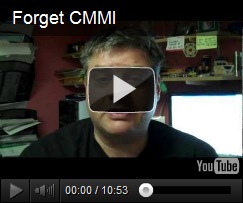I’m not sure, but I’m told some famous guy back in Biblical liturgy was once asked to explain the point of the Pentateuch (aka, the Torah, aka, The Five Books of Moses) while "standing on one leg".
I now undertake a task, possibly no less daunting, regarding CMMI. And, if there ever were anyone more appropriate to try it, I doubt I’ve met them.
Seriously though, much has been written here and many other places (not to mention eons of conference and user group content) about a number of "universal truths" about CMMI. Let’s get these out there first, but without dwelling on them:
- There are no "processes" in CMMI, only practices, and there’s a difference.
- The practices in CMMI are "what" but not "how".
- These practices are use to improve your processes, not to define them.
- The CMMI does not require the SCAMPI appraisal to be effective. You can use CMMI to improve your operation without ever using the SCAMPI to appraise your use of CMMI.
- 42. OK. Not really.
However, not a single one of these "truths" explain the point of CMMI, or, how to actually use CMMI. So, here it goes:
Each one of the practices in CMMI improves some aspect of your organization’s performance resulting from how you do your work. It doesn’t matter whether it’s providing a service or developing a product. And, it doesn’t matter whether you do so using so-called traditional development methods or Agile approaches. If you have performance issues in an area of your operation (called, "Process Areas" in CMMI), Check each of the practices in that area for activities in your operation that might be causing those performance issues.
It’s assumed, then, if you don’t have any issues covered by a practice then you don’t need to do anything about a practice, because you’re already doing it. This says nothing of how well you do it, why you do it, how you do it, whether you recognize that you do it, or whether the fact that you do it is a complete coincidental freak of nature, but, if you read a practice, understand the risk it avoids, and you don’t encounter that risk, you’re somehow performing that practice. Pretty simple.
I’ll repeat and summarize that two-step thought experiment:
- Look in the process areas for practices that address performance issues you’re experiencing with the operation of your work. When you encounter a practice (or more than one), the absence of which can explain why you’re seeing those issues, make appropriate changes to your operation so that you incorporate that/those practice(s) into your operation. Rinse and repeat.
- Practices that don’t represent risks or issues you’re not seeing are (pretty much, by definition) practices you’re somehow managing to accomplish. Don’t bother with them — unless you notice that you don’t like something about how you do it, but that’s a different priority/matter.
Keep in mind, this says nothing of
- whether what you do/don’t do will suffice as "evidence" for an appraisal
- how well you perform the practices (regardless of whether or not you perform them or believe you can use them to improve),
- what it takes to incorporate practices or make change, in general, happen in your operation,
- whether an appraisal team will concur with whether you do/don’t perform practices, or
- you interpret practices in constructive ways.
Nonetheless, if you internalize the significance of the above 2 steps, you can (I dare say, "will") save yourselves a lot of time and grief when using CMMI. This approach can certainly help you prioritize the practices for which to focus on, appraisal or not. And, if you do take this approach towards preparation for an appraisal, keep in mind the bulleted caveats and don’t try this alone.




